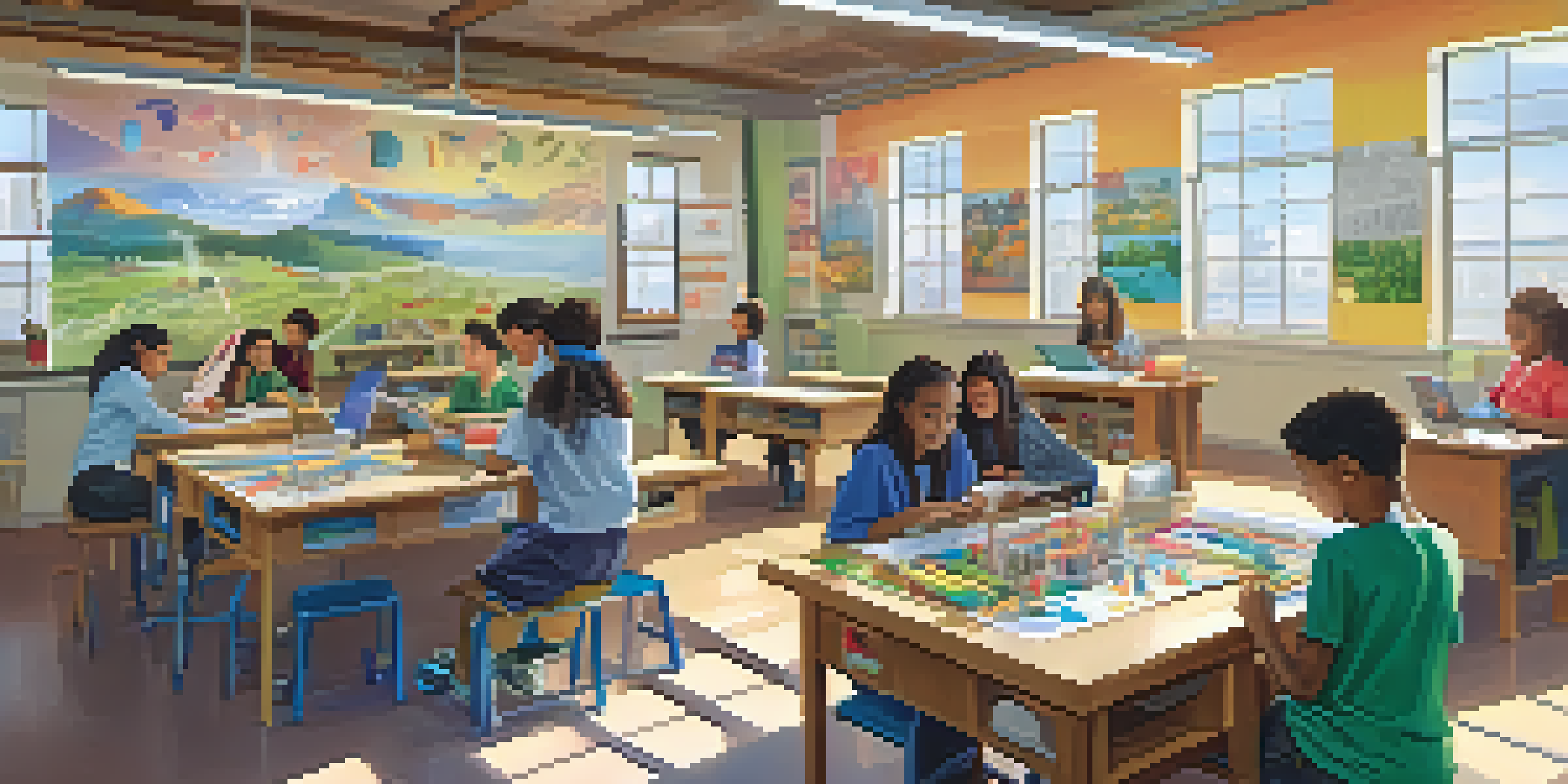Innovative Educational Programs in New York State Schools

The Rise of STEAM Education in New York Schools
In recent years, New York State has embraced the STEAM education model, which integrates Science, Technology, Engineering, Arts, and Mathematics. This approach encourages creativity and critical thinking, essential skills in today’s job market. By incorporating the arts into the traditional STEM curriculum, students engage more deeply and develop a broader skill set.
Education is the most powerful weapon which you can use to change the world.
Schools across the state have launched various STEAM initiatives, from robotics clubs to digital art programs. For example, many high schools now offer advanced courses in coding and graphic design, preparing students for lucrative careers in tech. These programs not only enhance academic performance but also foster a love for learning by making education more interactive and fun.
Moreover, collaborations with local businesses and colleges help provide students with hands-on experiences. Internships and mentorships bridge the gap between classroom learning and real-world applications, making STEAM education a pivotal part of New York’s innovative educational landscape.
Project-Based Learning: A Hands-On Approach
Project-Based Learning (PBL) is gaining traction in New York schools, allowing students to engage with real-world problems. This teaching method encourages students to work on projects that require critical thinking, collaboration, and creativity. By tackling projects that matter to them, students often find a deeper connection to the material, leading to enhanced retention and understanding.

For instance, some middle schools have implemented PBL by having students develop community service projects that address local issues, such as food insecurity. This not only educates students about social responsibility but also empowers them to take action. The result is a classroom environment that mirrors real-life challenges and promotes civic engagement.
STEAM Education Enhances Learning
New York schools are integrating STEAM education to foster creativity and critical thinking, making learning more engaging and applicable to real-world scenarios.
Furthermore, with the guidance of supportive teachers, students learn to manage their time, set goals, and reflect on their work. This hands-on approach equips them not just with knowledge but also with essential life skills that are invaluable in any career path.
Mindfulness and Social-Emotional Learning Programs
Recognizing the importance of mental health, many New York schools are integrating mindfulness and social-emotional learning (SEL) into their curricula. These programs aim to equip students with tools to manage stress, build resilience, and develop empathy. By prioritizing emotional well-being, schools create a more conducive learning environment.
The future belongs to those who believe in the beauty of their dreams.
For example, some elementary schools have adopted daily mindfulness practices, such as meditation or yoga, to help students focus and reduce anxiety. Research indicates that these practices can enhance concentration and improve academic performance, making them a valuable addition to the school day. Similarly, SEL programs help students learn how to communicate effectively and resolve conflicts peacefully.
As a result, these initiatives foster a supportive community where students feel safe and valued. When students are emotionally healthy, they are more likely to thrive academically and socially, underscoring the significance of mental well-being in the educational landscape.
Inclusive Education Practices for Diverse Learners
New York State schools are increasingly focusing on inclusive education practices to support diverse learners, including those with disabilities and English language learners. This commitment ensures that every student has access to quality education tailored to their unique needs. By fostering an inclusive environment, schools celebrate diversity and promote equity.
For instance, personalized learning plans are being developed to cater to individual learning styles and capabilities. Teachers are receiving training to implement differentiated instruction strategies, enabling them to adjust their teaching methods effectively. This approach not only benefits students with special needs but enhances the learning experience for all students in the classroom.
Project-Based Learning Empowers Students
Through Project-Based Learning, students tackle real-world issues, enhancing their understanding and retention while promoting civic engagement.
Additionally, schools are employing assistive technologies and resources to further support diverse learners. From speech-to-text software to bilingual education programs, these tools empower students to succeed academically while embracing their unique identities.
Enhancing Literacy Through Innovative Reading Programs
Literacy remains a cornerstone of education, and innovative reading programs in New York schools are making significant strides in enhancing students' reading skills. By incorporating technology and engaging reading materials, educators are transforming how students approach reading. Programs that focus on personalized reading experiences cater to students' interests and reading levels.
For example, many schools now utilize digital platforms that match students with books based on their preferences. These platforms often include interactive features such as quizzes and discussions, making reading more enjoyable and relevant. Additionally, after-school reading clubs encourage students to explore literature in a supportive and social environment.
Such initiatives not only improve reading proficiency but also nurture a lifelong love for books. When students find joy in reading, they are more likely to excel academically and develop critical thinking skills essential for their future.
Career and Technical Education: Bridging Classroom and Workplace
Career and Technical Education (CTE) programs are gaining momentum in New York State schools, providing students with practical skills for the workforce. These programs focus on equipping students with industry-specific knowledge and hands-on experience, bridging the gap between education and employment. As the job market evolves, CTE prepares students for high-demand careers in various fields.
For instance, high schools are partnering with local businesses to offer internships and apprenticeships, giving students a taste of real-world work environments. Programs in fields like healthcare, engineering, and culinary arts allow students to explore potential career paths while still in school. This exposure not only enhances their resumes but also builds confidence in their abilities.
Inclusive Practices Support Diversity
New York schools are adopting inclusive education practices to cater to diverse learners, ensuring equitable access to quality education for all students.
Moreover, CTE programs promote lifelong learning by encouraging students to pursue further education or training after graduation. By emphasizing skill development and career readiness, New York schools are empowering students to succeed in an ever-changing job landscape.
Technology Integration: The Future of Learning
Technology integration in New York schools is revolutionizing the educational experience, making learning more interactive and accessible. With tools like tablets, smartboards, and online learning platforms, classrooms are transforming into dynamic environments that cater to various learning styles. This shift not only enhances engagement but also prepares students for a tech-driven world.
For example, many schools have adopted blended learning models, combining traditional teaching methods with online resources. This flexibility allows students to learn at their own pace while receiving personalized feedback from teachers. Additionally, virtual field trips and online collaboration with peers from around the world broaden students' perspectives and enrich their educational experience.

As technology continues to evolve, so will its role in education. By embracing innovation, New York schools are setting the stage for future generations to thrive in an increasingly digital society.